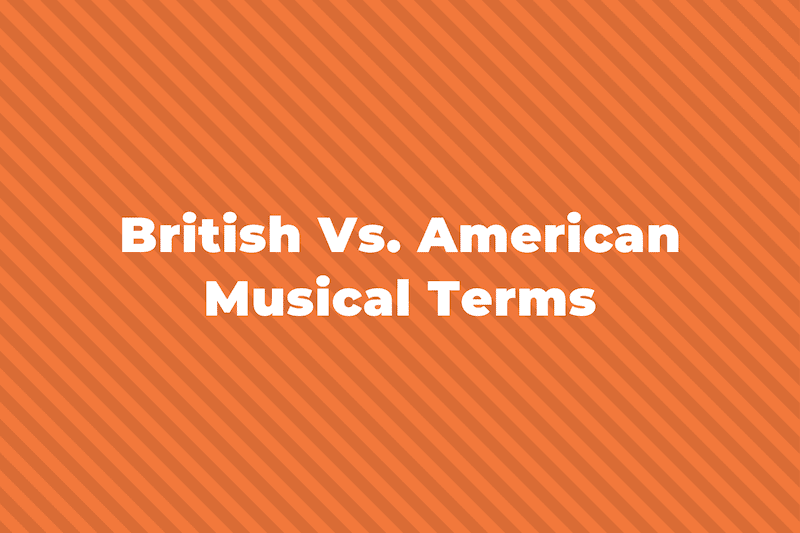One of the more common musical forms found in classical music is the Variational Form, more commonly known as Theme and Variation Form. It is found in works by many famous composers from the Classical, Romantic, Baroque, and Renaissance periods.
This post will answer the question, What is Theme and Variation Form? First, however, let’s take a look at just what exactly is Form in the first place.
What is Musical Form?
Form in music boils down to how the structure of the music is organized and analyzed.
When you write music, to get it to fit into a specific form, you have to follow structural and organizational rules.
You can also analyze these rules to determine what the form of a single, or multiple, pieces of music are.
We have a full post on Musical Form if you want to learn about it in more detail.
Most forms in music are analyzed by labelling each section of the piece with a letter – A, B, C, D, etc.
You would label the first section A, and then when you hear the music change to a different section, label that as B, and keep going from there, using the A again if that first section repeats.
Theme and Variation Form: Definition
Now that we know how Form is analyzed, let’s look at exactly what the Variational Form, or Theme and Variation Form, is.
As its name implies, a piece of music with this form would start with a “theme” – the fundamental idea, passage, or melody of the piece.
It is typically between 8 and 32 bars in length.
The first section would present the theme and be labelled “A”.
Every subsequent section would then have a variation on that theme.
As these sections are variants of the A section, each one would typically be labelled as A1, A2, A3, etc., so the overall formal structure of a Theme and Variation piece would read AA1A2A3.
You might sometimes see ABCD as the form, but that implies each section is more individual and separate from the others than is usually the case in a theme and variation.
We don’t exactly how theme and variation form came about, but one of the most prominent ideas is that it stems from the long court dances of the aristocratic party that were held in the 1600s and 1700s.
The musicians would get bored playing the same thing for hours on end, and would therefore invent variations sometimes to keep themselves and their guests more entertained.
However, because the dance required the main melody and structure to remain mostly the same throughout, they couldn’t change the theme completely, but just alter it slightly each time through.
Different Types of Variations
You can alter the theme of a piece in multiple different ways. Some common ways to vary the theme would be:
- Melodic
- Harmonic
- Rhythmic
To illustrate all of the different ways, let’s start with an easy and recognizable theme.
Here is the melody to “Twinkle, Twinkle Little Star”.
Melodic Variation
The first way would be a melodic variation – this is when you change the melody of the theme, but largely keep the harmony and rhythm of the melody the same.
Here is an example of a thematic variation on a melody.
Notice how the main melody notes appear in roughly the same place they did before, and it’s not faster or slower.
The melody is just more decorated and elaborated on in this example.
Harmonic Variation
The next way to vary a theme is harmonic – you can change the underlying harmony that either accompanies or is implied by the melody.
Here is a harmonic variation on the “Twinkle” melody.
Notice here how the melody doesn’t change, but the harmony below it is different than would normally be there.
Rhythmic Variation
The third main thematic variation is the rhythmic variation.
This is when you keep the harmony and melody mostly unchanged but you break the rhythmic pulse of the piece and create syncopation.
Other Variations
Another type of variation you can do is change the melody, or the theme overall, from the major key to its parallel minor, or vice versa.
In this case, the “Twinkle” melody has been in C Major, so here it is in C minor.
As you can see, it doesn’t look drastically different, but when played with minor harmonies it gives off a very different feel.
Examples Of Theme and Variation
Here is a composition by Mozart called “12 Variations on ‘Ah vous dirai-je, Maman’.
It takes the tune of “Twinkle, Twinkle Little Star”, as we have just done, and gives 12 thematic variations. See if you can point out the different types!
Another example is a piano piece by Chopin that features 16 continuous variations on an unchanging bass line.
Originally called “Variantes”, he changed its name to “Berceuse”, Op. 57.
Here is an example from Bach, titled “Canonic Variations on ‘Vom Himmel hoch da komm ich her’”:
Summing Up
That is all there is to know about the Variational Form, all called the Theme and Variation Form.
It is one of the easier forms to write in and to notice, because each section uses the same main theme, just altered a bit to make each new part unique.
We hope you were able to take a lot out of this post, and if you have any questions let us know.



